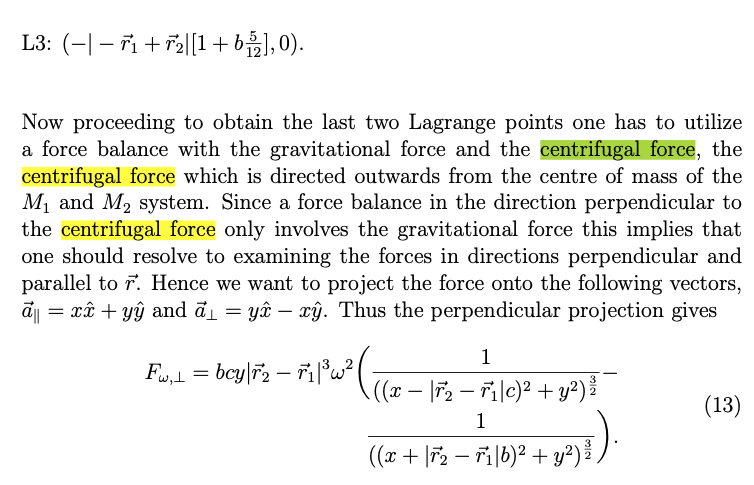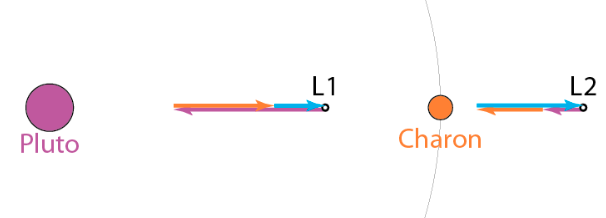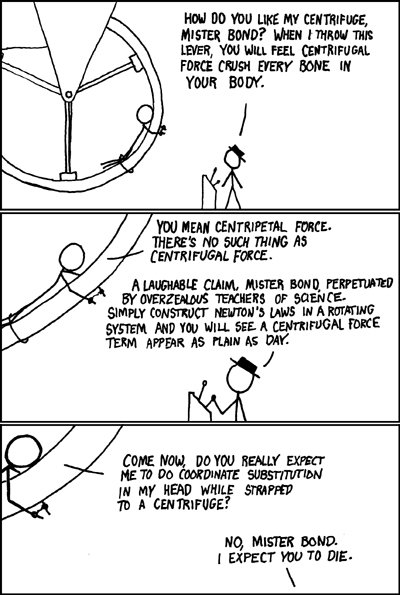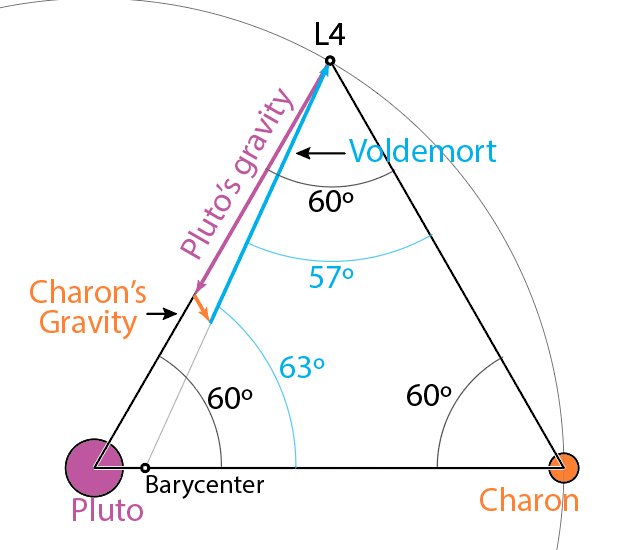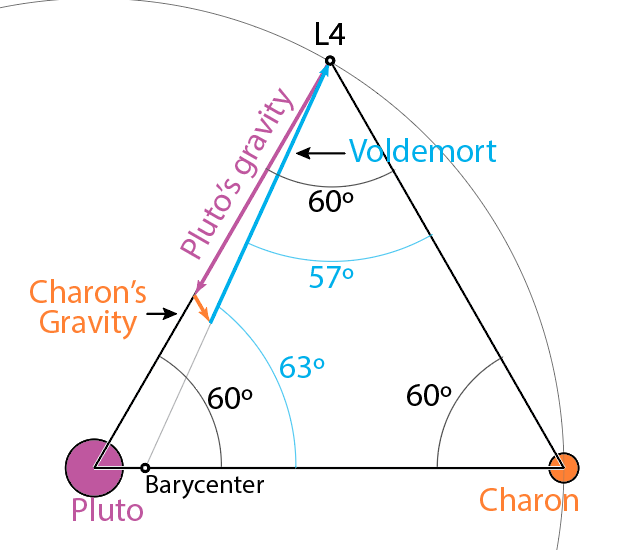-
Posts
37 -
Joined
-
Last visited
Contact Methods
-
Website URL
http://hopsblog-hop.blogspot.com
Profile Information
-
Location
Ajo, Arizona
-
Interests
art, math, geometry, space exploration, science fiction
-
Favorite Area of Science
orbital mechanics
Recent Profile Visitors
2292 profile views
HopDavid's Achievements

Quark (2/13)
-1
Reputation
-
A nice paper, thank you. As with most papers I've seen looking at Lagrange points they consider the centrifugal force along with the gravities of the central and orbiting bodies. Screen capture of one of the paragraphs attached. They also look at Coriolis force (another pseudo force which is actually inertia in a rotating frame). I might try to look at that. I've heard that Coriolis force helps keep L4 and L5 stable. But I've never grokked the notion.
-
Continuing with the question "Do you know any other situations when he was wrong?" ... So far I've listed some of Neil deGrasse Tyson's basic flubs in physics and astronomy. There are even more embarrassing errors when he ventures into realms outside his supposed area of expertise. Tyson is really, really bad at history. See Tyson's video My Man, Sir Isaac Newton. Tyson has Newton explaining elliptical orbits and single handedly inventing calculus in just two months, on a dare. All before he turned 26. It was in Principia that Newton explained elliptical orbits and it was Edmund Halley's famous question that prompted Newton to write Principia. I'm guessing this is the encounter Tyson is trying to describe. Halley asked his famous question in 1684 when Newton was in his 40s. Seven years after Newton worked out that inverse square gravity implies Kepler's laws. So, no, Newton didn't work out planetary orbits on Halley's "dare". Newton started thinking about gravity and planetary motion in 1665 and made his break through in 1677. Link. It took him 12 years. Not two months as Tyson claims. Newton did do his calculus work before he turned 26. This is one of the few things Tyson gets right. But obviously not because of Halley's "dare" made nearly 20 years later. And it was not a two month effort. Both Newton and Leibniz built on the efforts of Fermat, Descartes, Kepler, Cavalieri, Wallis, Gregory, Barrow and others. These men laid the foundations of modern calculus in the generation before Newton and Leibniz. Historian Thony Christie looks at this in his essay The Wrong Question. Christie argues (effectively in my opinion) that calculus was the collaborative effort of many people over many years. Thony Christie also does an entertaining critique of Tyson's timeline in his piece Why Doesn't he just shut up? Although wildly inaccurate Tyson's Newton stories seem like a harmless piece of fictitious history. They are actually flattering to Newton. But then Tyson goes on to use this to slander Newton. And this is the reason I invest time and effort calling out Neil's incompetence. I don't really care if he tells his pseudo nerd fans there are more transcendental numbers than irrationals. But Neil's revisionist history is a serious offense. And I am trying to make his revisionist histories widely known.
-
Okay, for the moment let's pretend L4 and L5 don't exist and let's focus on L1. Have you ever calculated L1 distances? I have. See my spreadsheet of L1 and L2 points for various bodies in our solar system: Link I used equations from Szebehely's "Theory of Orbits - The Restricted 3 Body Problem". How did Szebehely get his equations? He considered three vectors: gravity of central body, gravity of orbiting body and centrifugal force. He talks about centrifugal force on pages 8, 38, 629-633 of that book. Have you heard of Jerrold Marsden? Check out section 8.6 of his Introduction to Mechanics and Symmetry. Or Shane Ross? From his explainer of how to calculate the collinear Lagrange points: "The effective potential energy (also called the augmented potential) is a way to include both the effects of gravity and the centrifugal force of the rotating frame. The critical points of the effective potential energy function, Ū(x,y,z), are the Lagrange points, equilibrium points in the rotating frame (a.k.a., relative equilibria)." Marsden, Ross, Lo and Koon enjoyed some notoriety for their Interplanetary Transport Network ideas. Check out page 36 of their online textbook Dynamical Systems, the Three-Body Problem and Space Mission Design. TL;DR Plenty of bonafide mathematicians and engineers are quite comfortable using the term "centrifugal force". Your attempt at a gotcha is actually an embarrassing tempest in a teapot. Attached is my illustration of the Pluto Charon L1. Please elaborate on your "excess gravity" concept. How would you redraw this without using the vector that will not be named?
-
Because I use the term "centrifugal force"? So are you saying Randall Monroe is a crank? (see attached image). You are presumptuous to appoint yourself the voice of main stream science. Plenty of engineers and scientists use it while acknowledging it's a fictitious force. It's very convenient in many scenarios.
-
If you Google Hop David you can find me. I also go by Hollister David. I am not hiding behind a pseudonym. None of the incorrect Lagrange explainers I've seen make mention of centripetal force force or excess gravity. Can you show me equations precisely calculating "excess gravity"? In the attached diagram the center of the Pluto Charon system is the barycenter. Centripetal force is force pointing towards the center. Which of the three vectors I show would you call centripetal? None of them point towards the center of the system. The magnitude of all three vectors I can figure precisely. How would you redraw this diagram for your students?
-
In the other thread you said d'Alembert introduced m ω2 r. Huygens derived his expression for centrifugal force in 1673. Lambert was born 1717. I didn't check it out further after that. In any case that thread was about Tyson.
-
First off nothing you've said refutes anything I wrote. Secondly this isn't speculation. Rather it is freshman physics. Thirdly The Lounge description says "Discuss life, work, school, anything!" However it seems somebody transferred this to a different forum. I'm okay with classical physics.
-
In this subthread it was you who engaged me. I gave an example of Neil botching basic physics. Link. Which was quite on topic in this thread on Neil Tyson. To refresh your memory I was talking about Neil's claim that tripling rotation rate triples artiflcial gravity. A flub that shows incompetence in basic physics. You jumped in with an irrelevant comment that you seemed to think refuted what I said. Your attempt at a gotcha does not make Neil's flub go away. I get it. You'd rather not talk about Neil's errors in this thread on Neil Tyson.
- 113 replies
-
-1
-
"Your Thoughts On Neil deGrasse Tyson" is the topic of this thread. And I've offered my thoughts. In my opinion Tyson is a source of misinformation. To support this I've offered examples of Tyson making wrong claims. Including an example of Tyson botching basic physics. You took issue with one of my terms and diverted this thread into an off topic tangent. I've made a separate thread: Lamentable Langrange Articles. We can argue over verboten terms over there. In this thread the topic should be our thoughts on Neil deGrasse Tyson.
-
Lamentable Lagrange Articles The Lagrange points are one of my interests. I am a little obsessed with the Earth Moon Lagrange 2 point. One of my pet peeves are wrong explanations of these five locations. So many articles and Youtube videos claim these are locations where gravitational forces cancel each other out. One of many examples is Fraser Cain's video What Are The Lagrange Points? Finding Stable Points In Space. From that video: People often sensibly ask about L2 and L3. At both these locations the central and orbiting body both pull the same direction. How do those cancel each other? Or at the L4 and L5 where the gravity vectors are 60º from each each other. The only place where the two massive bodies pull in opposite directions is L1. And even at that location gravity does not cancel out. At the Sun Earth L1 point the sun's pull is about 34 times that of earth's. So, nope, the opposing gravities do not cancel at that location. At the Earth Moon L1 the earths pull is about 2.6 times that of the Moon's. So, nope, gravity doesn't cancel out there either. It's a three man tug of war. Enter Voldemort. There are three men in this tug of war. At the Earth Moon L2 the Earth and Moon are pulling the same direction against a third man who, like Voldemort, shall not be named. At the Sun Earth L1 point the earth is helped by Voldemort who at that location in nearly as strong as the sun's gravity. At L4 and L5 Voldemort is pulling nearly opposite the central body's tug. But not directly away from the center of the central body. Rather away from the barycenter of the two massive bodies. So Voldemort exactly cancels the central body's gravity and the small sideways tug of the orbiting body. I've attached an illustration of the Pluto Charon system. Pluto and Pluto's gravity is purple. Charon and Charon's gravity I've colored orange. And Voldemort is colored blue. Voldemort is Centrifugal Force The unnamed contestant in this three man tug of war is Centrifugal Force. Just about everyone is familiar with centrifugal force. It's what you feel on a spinning carnival ride. Or in a car making a turn. Why do high school physics teachers refuse to mention centrifugal force? Is it a ruthless entity set on world domination? No. It is avoided because "centrifugal force" or "centrifugal acceleration" are misnomers. It is not truly an acceleration. Rather it is just inertia, the tendency to travel in a straight line. However in a rotating frame inertia feels like a force. And, indeed, it can be treated like an acceleration if you're in a rotating frame. The pseudo acceleration can be expressed as ω2 r. Where ω is angular velocity in radians over time. Clueless Pedantry. It is a good thing to distinguish between inertia and acceleration. In my opinion it is sufficient to preface the term with "pseudo" or "so called" and proceed to use this pseudo force or acceleration when examining rotating systems. It is commonly used by engineers and even physicists. Coriolis force is also commonly used even though it is not truly a force. Dealing with this by eliminating it from our lexicon will lead to confusion. As illustrated by the many Lagrange explainers that are completely incorrect.
-
How about m ω2 r ? Is that wrong? Are you okay with Tyson's m ω r ? Do you think tripling RPMs triples weight?
-
I am talking about m ω2 r. Huygens called this centrifugal force. Newton called this centrifugal force. Even Tyson calls this centrifugal force (one the of the occasions I agree with him!). In the case of orbiting bodies it is gravity that provides the centripetal force. Gravity is m μ / r2. This is often different from m ω2 r. Only in the special cases of circular orbits is m μ / r2 = m ω2 r So I would prefer to continue using the term centrifugal acceleration or centrifugal force. I have already acknowledged that it is actually inertia in a rotating frame. If you are in a rotating frame it is convenient to call inertia a force. But if you like I could call it artificial gravity Sooo... Isn't it freshman physics that artificial gravity in a rotating space station is m ω2 r ? Notice that I bolded the exponent. Evidently in your freshman class the label you gave it is more important than the exponent. Tripling the RPMs does not triple the weight as Tyson claims.
-
Please reread what I wrote. Centripetal is towards the center of rotation. Centrifugal is outward. ω^2 r gives what seems like outward acceleration in a rotating frame.
-
Nope. In orbiting bodies gravity provides the centripetal force. In a spinning space station floor of the space station exerts centripetal force. The so called centrifugal force (actually inertia in a rotating frame) pushes outward. I'm attaching the relevant XKCD comic:
-
Neil invests quite a bit of time and effort on showmanship: vocal delivery, crafting palatable soundbites and jokes, wardrobe, hand gestures, etc.. He is a great showman! But he often neglects to review the topics he supposedly explains. So much of his material is wrong. Here's Neil saying rocket propellant mass goes exponentially with payload mass: Link. It would have taken him five minutes to dust off his college textbooks and review the rocket equation. Or here's Neil saying the James Webb Space Telescope is parked at sun earth L2 point in earth's shadow: Link. I admit I thought they were going to park in earth's shadow, it would make sense for an infra red telescope that needs to be kept cold. But for various reasons they put it in a large halo orbit around the L2 point. Before using that notion in explainer he should check if it's true. However his wrong math and science are merely annoying. It's not like 99.9% of his audience will ever need to know how to calculate centrifugal force, for example. It is Tyson's wrong history that makes me angry. For example Neil was telling Fareed Zakaria that nobody thought of miniaturizing electronics before NASA came along. He credits NASA for starting the electronics revolution that started picking up momentum in the 60s. It is true that NASA as well as the military funded R&D for miniaturizing electronics for compact and light weight rocket and missile avionics. This probably did put the U.S. in the lead in pushing Moore's Law for a time. But the miniaturization of electronics was already well under way by the time NASA came along. People were using transistor radios years before NASA was formed in 1958. Wikipedia has a nice article on the history of the transistor: Link. I completely agree with Neil that NASA has been a technology driver and should be better funded. But making up bull shit history to support this talking point can do more harm than good, in my opinion. And then there's Neil's fictitious histories that he uses to support opinions I disagree with. I'm fine with differing opinions. But I'm not fine with using misinformation to push a narrative.






